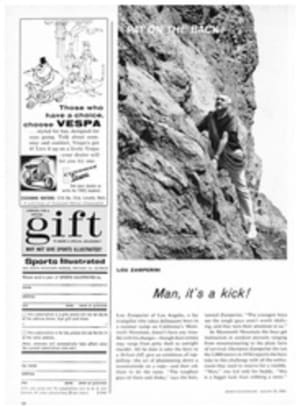
A 'bag of tricks' crammed with bargains
The French have a phrase, "tonic la ' boutique,' " which means "the whole bag of tricks." This summer, at the same time that Italian and French designers of the haute couture were showing their mostly disappointing fall collections to the largest gathering ever of store buyers and press, their own boutique collections were full of sportswear that contained, if not "the whole bag of tricks," at least a good share of them.
Europe's boutique creations now have the same kind of outdoor vitality one finds in American sportswear. Whether situated on the elegant ground floor of a designer's Paris atelier or the sandy informality of a Riviera beachfront, the boutiques are crammed with fashions and bargains.
In the cool, gray quiet of Christian Dior's Paris boutique are buttery suède coats, collectors' sweaters and knit costumes that exude the very air of the Bois de Boulogne. The knitwear starts at $50, for soft cable-stitched pullovers with collars of knitted loops, and goes on up to such luxuries for travelers or spectators as three-piece costumes of cashmere, with ribbon-edged jackets, sleeveless pullovers and pleated skirts.
While every fashion house in Paris denies that it copies itself in its own boutique, each reflects the personality and lines of the designers in charge and the prevailing trends of the season. Many smart young girls in Paris know that the successes of the couture turn up in boutique versions later in the season. And the difference in price certainly makes them worth waiting for. For example, a pink fleece coat that would be perfect at Longchamp or Santa Anita is fitted in front and straight-hanging in back, giving the owner the up-to-the-minute look of the fall season for $155, less 20% for traveler's checks, a buy hard to duplicate for value anywhere in the U.S.
Suède and python skins
Nina Ricci's boutique export business has grown so that the house has established a "little collection" designed by Ruben Torres, protégé of Couturier Jules Crahay and onetime designer for White Stag of Portland, Oregon. At collection time in July, 200 different styles were shown with as much drama as at a big couture opening. Leather, cut like the less sporting materials upstairs in Crahay's collection, was the hit of the show. The su√®de poncho shown in the illustration above, for example, has the same swirling silhouette, buttoned on one side, as the capes that were Crahay's big couture successes. It costs $240.
Sporty little raincoats have become the uniform of such New Wave actresses as Pascale Petit and Jean Seberg, and some kind of way-out slicker is in every boutique. Nina Ricci has one, for instance, that is a black-rubber balmacaan lined with gray flannel. And Aldo Chiesa of Turin has a raincoat made of six python skins.
Chanel is a designer whose great contemporary success is based on the easy cardigan jackets and walking skirts of her suits. She is also one of the few designers in Paris who don't have a boutique downstairs. Fortunately for the woman who likes the casual Chanel cut of things (and just about every smart woman in Paris does), almost every shop on the Faubourg Saint Honoré is in effect a Chanel boutique. To her delight these shops all copy her suits—Chanel is one designer who actually encourages the copycats. The collections had hardly been shown before the new look of Chanel's tweeds, so soft they looked like knits, trimmed with fuzzy wool and braid, and with bar pins clutching the jackets above the bosom, began showing up in all the windows.
One boutique that has not been affected by the caprices of French designers this season or any season in its 100-odd years is Hermes, the saddle, leather and sportswear shop on the Faubourg Saint Honoré (SI, May 23,1960). Hermes might be called the purveyor of the chateau look. Its customers include such chatelaines as the Duchess of Windsor, Suzy Volterra and the Princess de Réthy. Leather is the thing this season as always at Hermes, and a leather golf skirt is $100, a leather coat $400. Hermes' well-known silk scarves are now made up into casual skirts, and they're selling very well, for $40.
Meanwhile, in Saint Tropez, at Madame Vachon's (she's the Balenciaga of the Bardot beach set), this summer's bargain is a traffic-stopping outfit composed of hip-level pants—a bikini with legs, you might say—and an abbreviated pullover top that leaves about eight inches of skin showing. All this for $12. Anyone who could was wiggling into them last week, tended by shopgirls who rushed around with folding screens for dressing rooms.
In Italy the boutiques are even more important than they are in Paris, and they are as varied and as full of local flavor as Italian wines.
The little shops of Rome's Via Condotti and Capri's Piazza Umberto produce such made-to-order-overnight items as sandals, pants and sweaters. Italy's fashion industry would be a commercial flop, in spite of its grandiose showings in Renaissance palaces, if it weren't for the excitement of the boutique collections that every designer brings out in advance of his haute couture collection. One buyer for an important group of American stores says he spends 80% of his money on sportswear items. "Italian sportswear," he says, ' "fits American women like a suntan."
Pink stockings and pagodas
Award-winning designer Emilio Pucci, who practically invented stretch fabric, is still the most inventive user of it. He even has contrived one of his one-piece capsulas in stretch velveteen with a V-necked beaded top and suggests that modern women will wear it to the opera. (Perhaps at La Scala, not yet at the Met.) Skier Pucci makes bulky pile-lined parkas of skipper-blue poplin that are meant to be worn over bulky turtle-neck sweaters with matching pompom knit hats. The parkas have diagonal zip closings and were shown a week before all the Paris houses went on a diagonal-closing kick. Pucci also has made gray-flannel travel suits of a stretchable wool that could be among the most prophetic developments on the European fashion scene this year.
Other after-ski clothes in the Italian boutique collections could costume a commedia dell' arte production of The Threepenny Opera. There are figure-hugging knitted skirts and cardigans that button to the knees, to be worn with pink stockings. Knitwear designer Laura Aponte showed little-boy suits of black-and-white checks with belted jackets over long tight pants. The ragazzo look was emphasized with flappy oversized caps.
Italy's high priestess of what to wear after skiing at Gstaad or when you're giving a dinner party and somebody else is doing the cooking is Princess Irene Galitzine. Among the major innovations at her showing in Florence were her flared tunic tops of pastel silk worn over flared pajama-leg bottoms, giving the silhouette of a Chinese pagoda, an image enhanced by huge bibs of beads. Galitzine also has solved what has been an uncomfortably perplexing problem: how to hide the instep strap that keeps stretch pants stretched. She uses fringe or loops or little scarves to obscure the objectionable strap. The work of this fine Italian hand permits the discarding of the clumpy boots that everybody else uses to hide the strappings and the use of Galitzine's little-heeled pumps instead.
Italian knits are world-famous and have become the most important single transatlantic fashion commodity. The current leader of the Italian knitwear business is the Marquesa de Gresy, whose sportswear firm of Mirsa is so busy that she shows a collection only out of deference to the Italian couture group; she can't handle any more customers. Russell Carpenter of I. Magnin in California leaves a $1 million order with Mirsa each season. And when the Mirsa sweaters and dresses arrive at Magnin's the customers already have left orders for everything that comes, sight unseen. At the showings in Florence, the Mirsa knits were paraded by three models, walking abreast, wearing the red, white and green of the Italian flag as a salute to the 100th anniversary of the republic and to the 10th anniversary of the Italian alta moda.
ILLUSTRATION
TOD DRAZ
SUÈDE PONCHO IS HIT OF RICCI BOUTIQUE
ILLUSTRATION
TOD DRAZ
POMPOM HAT, diagonal-zipped parka make Pucci's ski pants seem slimmer than they are.
ILLUSTRATION
TOD DRAZ
PAGODALIKE PAJAMAS from Galitzine are made for St. Moritz and not for the boudoir.

